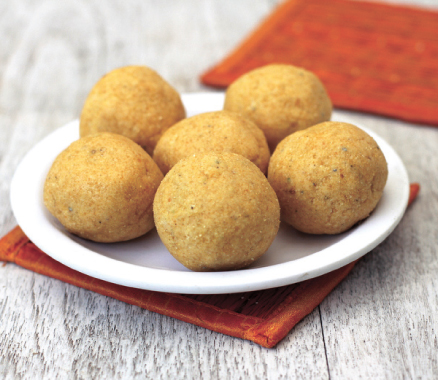Mama’s Punjabi Recipes – Moong Di Dhuli Daal De Namkeen Laddu (Skinless Moong Daal Salty Balls)
Indians love to eat fried foods, whether its pakoras, samosas, puris, kulchas or so many other things. The power of deep frying – and then eating the food hot – makes the average Indian’s mouth water! Namkeen laddus are a cross between a bhalla – which is made with urad daal – and a pakora, which is made with besan, which is after all just ground up channa daal.
Namkeen laddus are not the same as sweet laddus, which are made of small granules of fried gram flour that are cooked in oil and then rolled into shape. Namkeen laddu is made of skinless moong daal, which has a different, crunchier granule texture and a unique taste when eaten alone with a sauce. These are also easily used to make a curry or can be soaked in plain yogurt and eaten with imbli (tamarind chutney).
The green moong daal comes from the moong beans and is high in carbohydrates and protein as well as Vitamin B3 (Niacin), calcium, magnesium and phosphorus. This daal is universal to all parts of not only India but the rest of Southeast Asia where it is prepared in regional dishes. When the skin is removed, the daal is light yellow in color which tastes different when cooked. It is this skinless daal – also called dhuli moong ke daal – that can be used in the preparation of namkeen laddus.
Ingredients:
2 cups dhuli moong daal (skinless moong daal)
4 cups vegetable or sunflower seed oil
Spices (to taste): namak (salt), mirch (red pepper), garam masala, adrak powder (ginger powder)
Directions:
1. Soak the dhuli moong daal for at least two hours in cold water.
2. Pour the water out of the saucepan through a sieve and then run the daal thru a grinder set on fine so that it comes out like a paste and mix in the spices.
3. Pour the oil into a wok or kadai and warm it up to hot.
4. Take a spoonful of the paste and gently place it into the oil. Continue to add more spoonfuls but do not crowd them in the kadai.
5. The laddus will immediately fluff up, so turn them frequently till they are light brown and take them out of the oil quickly, placing them on a paper towel to soak up the excess oil and cool down.
6. These taste best with chutney or they can be set aside to be used in making a curry or served soaked in yogurt.
Shakuntla Malhotra is a skilled cook of Punjabi dishes made in the old-fashioned style that she learnt as a young woman in her ancestral home in Lyallpur, India before it became part of Pakistan after the Partition in 1947. People have often admired her cooking for its simplicity and taste that comes with each mouthful. Even in her mid-eighties, she continues to cook daily and agreed to share some of her delectable Punjabi recipes.
MAMA’S TIP OF THE WEEK
In the US, many people are now choosing not to make roti (flat bread) at home and instead are buying them ready made in the frozen section or freshly made from local restaurants or even using substitutes such as tortillas or pita bread or other Middle Eastern flat breads. But making rotis on the tava at home is quite simple and you can control the type of flour, the texture and the sugar or salt content (you put none in the atta). Once you get in the habit, it is quite fast and your family will enjoy the rotis.
One of the most basic things to remember is to only pour the atta into a dry bowl to begin with and then slowly add the water to make the dough. If you pour it into a wet bowl, the atta will stick to the sides and won’t come off, making a mess of the bowl. By the way, a wet dab of atta is often used in rural India to join pieces of paper as it is excellent glue once it is dry.


